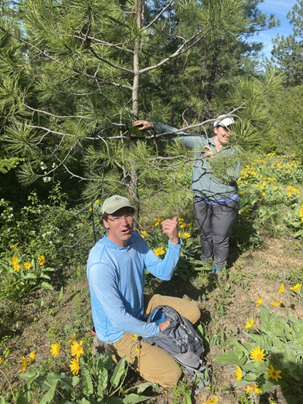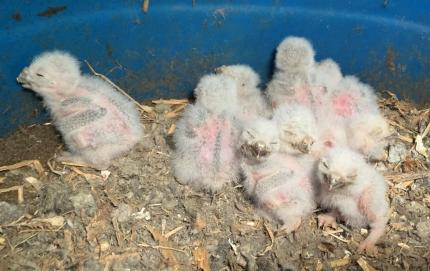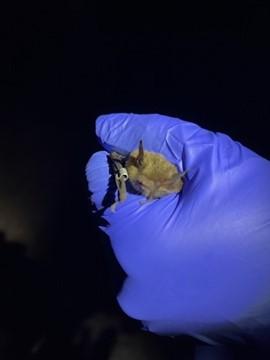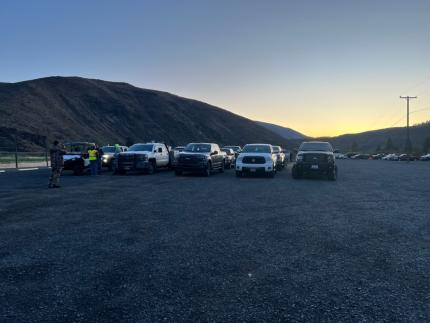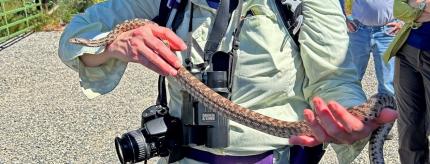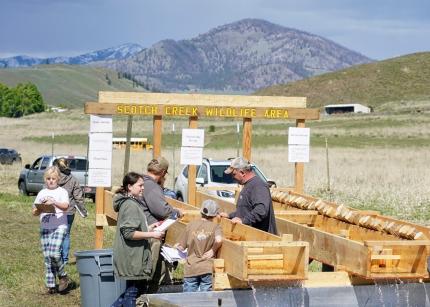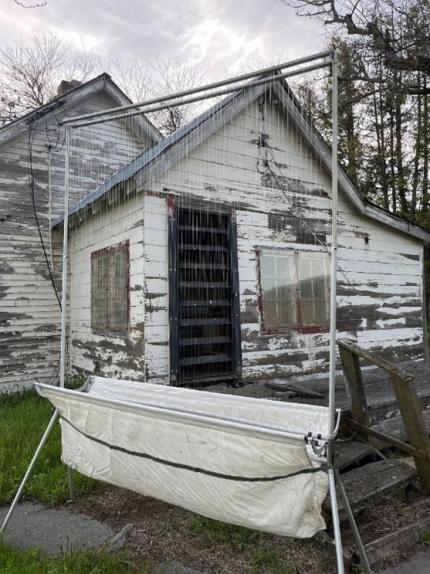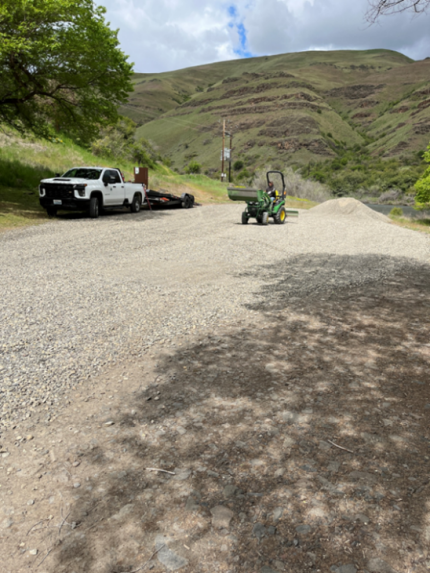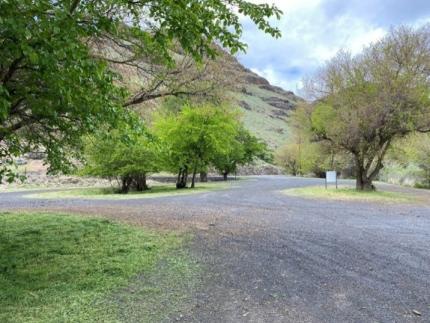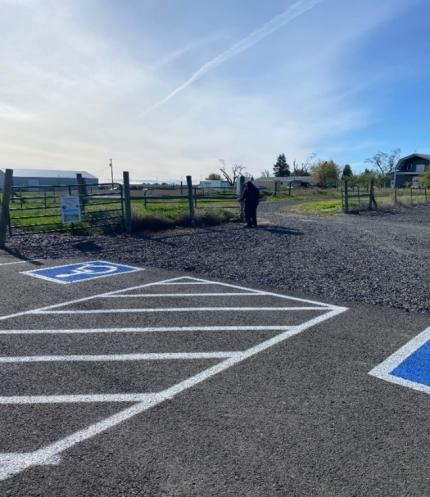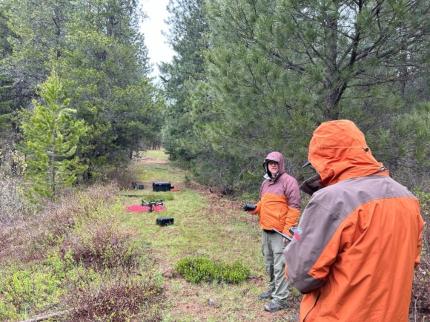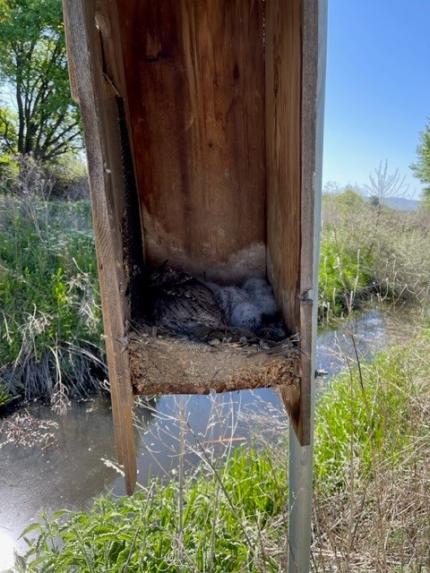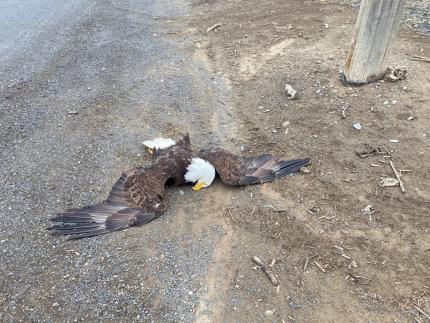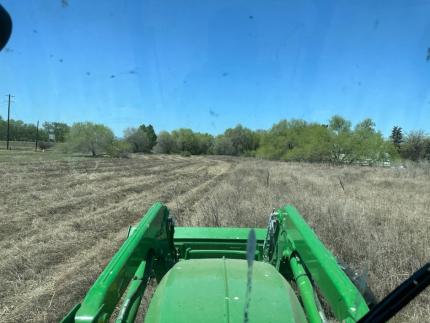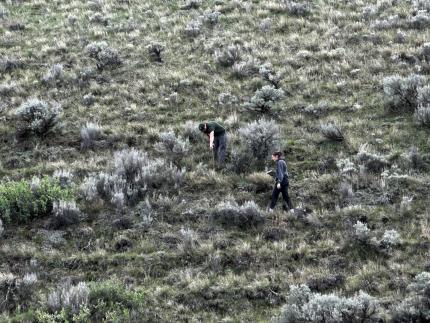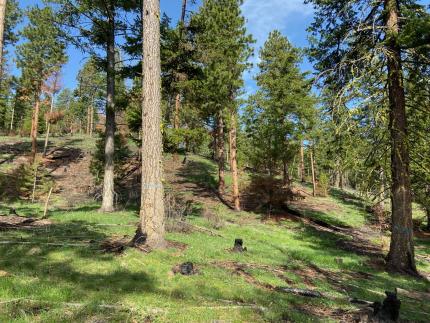Biweekly report May1-15 2025 - Region 5 (Southwest)
Managing Wildlife Populations
Black-tailed Deer Study Update: Regional wildlife biologists, Ungulate Section staff members, Science Division staff members, Conflict Specialists, wildlife area staff members, Habitat Program staff members, as well as biologists from Washington Department of Fish and Wildlife (WDFW) Region 6 continued work on the black-tailed deer project. Thirty-six black-tailed deer were captured by helicopter net gun earlier this winter. The deer are located within GMUs 556 (Toutle) and 550 (Coweeman), on a combination of state and private industrial forestlands. The captured deer were fitted with GPS collars and evaluated for body condition. Researchers took various biological samples before releasing the animals on-site.
Following a period to allow the deer to settle after the capture event, cameras have been placed within the home-range of each deer. Two or three cameras are currently deployed within the range of all study deer that remain alive, depending on the size of the deer’s range. The cameras focus attention on both forested and unforested habitats. Each camera station is also equipped with a device known as a proximity sensor which can detect when the deer’s collar is close to the camera, even if no photos were taken.
In aggregate, the collars, cameras, and sensors monitor the population of both the known deer within the study areas as well as unmarked deer that are also encountered. It is anticipated that these methods will produce sex and age ratios, and they may eventually be able to generate population abundance as well. This pilot effort is being explored within the forestlands of WDFW Region 5 / District 10 with the hope that it will prove to be a suitable tool for monitoring the secretive black-tailed deer in their forested habitats throughout western Washington.
Thanks to the many WDFW staff members who have participated in the project and thanks to the newly formed Blacktail Deer Foundation for their support and encouragement.
Providing Recreation Opportunities
Martins Bar: With the busy summer season quickly approaching, water access area staff members have been busy getting prepared. One site in particular, Martins Bar Access Area in Woodland, gets quite a lot of traffic almost year-round, and even more so in the spring and summer months. Since the early spring, access area staff members made improvements to the site’s parking lot by putting down fresh gravel and placing jersey barriers in the center of the parking lot to deter the public from peeling out. Additionally, staff members have painted the ends of the barriers white to make them more conspicuous for low light conditions.
Access area staff members have observed several garbage dumps and issues with graffiti. Silverlake restrooms and parking lot got hit pretty hard with multiple tags, which required pressure washing and painting over the graffiti. Also, there was a large garbage dump at Martin’s Bar access site where the access area team found ten large bags of garbage from a local coffee shop.
Kress Lake had a large cottonwood tree come down on the walking trail last week. It took two days to clean up and remove the tree and debris from the trail and ADA access fishing spot. Access area staff members have also been working on weed eating several sites including Kress Lake, Vancouver Lake, and Shilapoo access areas.
Providing Conflict Prevention and Education
Injured Eagle: Wildlife Conflict Specialist Jacobsen received a report of an injured bald eagle in Klickitat County. A passing motorist had picked up the eagle that night before WDFW staff members arrived. Officer Bolton took possession of the eagle the following day. After meeting up with Officer Bolton and assessing the eagle, Jacobsen determined that the eagle had suffered a severe wing break and was not a candidate for rehabilitation. Jacobsen euthanized the injured adult bald eagle.
Deceased Deer in Yard 1: Wildlife Conflict Specialist Jacobsen responded to a report of a deceased deer in a resident’s yard. When Jacobsen arrived, the homeowners had their kitchen butcher knife out and were attempting to salvage the deer meat for consumption. After inspecting the deer, Jacobsen strongly advised the homeowner NOT to consume the meat from this deer. The deer died of an unknown cause (likely disease), was in poor body condition, and, having been dead for several hours, had developed a strong odor. The homeowners eventually agreed that salvaging the deer was probably not the best option. Jacobsen disposed of the carcass.
Deceased Deer in Yard 2: An elderly homeowner contacted Wildlife Conflict Specialist Jacobsen to report that she had recently come home from vacation and found a deceased deer right next to her door. The odor was extremely strong, and the homeowner had no way of removing the deer. Jacobsen held his breath and loaded up the decomposing carcass that was crawling with fly larvae. The carcass began falling apart as soon as Jacobsen picked it up, but most of the pieces made it into the back of his truck. Jacobsen disposed of the carcass for the very appreciative homeowner.
Deceased Deer in Yard 3: Wildlife Conflict Specialist Jacobsen and Biologist Bergh spoke with homeowners in a neighborhood with chronic deer feeding issues. There had been multiple reports of deceased deer in this neighborhood, and supplemental feeding was a likely cause. Jacobsen provided information regarding the risks to deer associated with supplemental feeding and also advised homeowners of the new law prohibiting the feeding of deer in Washington.
“Bobcat-Domestic Cat Hybrid”: Wildlife Conflict Specialist Jacobsen and Officer Way fielded a phone call from an extremely concerned homeowner regarding what she reported as a “huge bobcat-domestic cat hybrid” that was living in her house. The homeowner reported that she let the animal into the house several months prior but that it had started acting aggressively. The homeowner reported that the mother and daughter were now afraid to live in the same house as the animal. Jacobsen passed their contact information along to a local cat rescue who may or may not be able to help. The following picture was provided by the reporting party:
Badger Stuck in Fence: Wildlife Conflict Specialist Jacobsen was driving along a highway in east Klickitat County when he observed a small animal run across the road in front of him. Suspecting it was a badger, Jacobsen slowed down and looked out his window as the animal scurried across the road and through a fence. However, as Jacobsen watched the badger squeeze through a square in the woven-wire field fence, the badger managed to get its tremendously long claws hung up on the fence and flip upside down on the opposite site. After a few moments where the badger didn’t move, Jacobsen realized the badger was stuck and pulled his truck over to assist. The attached photo shows how two of the badger’s claws from its front left leg got stuck on a wire strand and incapacitated the animal. As Jacobsen approached, he also saw a white fluffball near the badger’s mouth - a young badger kit! Jacobsen gently popped the badger’s claws loose from the fence, and it righted itself on the other side. Grabbing its kit in its mouth, the badger hissed at Jacobsen and quickly backed away with the kit in tow. The badger then reached its den and backed itself and the kit down the hole to safety.
Deer Stuck in Fence: A passing motorist observed a deer stuck in a fence and contacted Wildlife Conflict Specialist Jacobsen. Jacobsen responded to the area, but after several back-and-forth passes along the road, was unable to locate the deer. Officer Bolton also responded to the area to assist. Jacobsen stopped to talk to a nearby landowner, who reported seeing an injured deer walking on his property a few minutes prior. Jacobsen searched for the deer and while searching, the landowner received a real-time cellular trail camera photo of the deer walking through his property. Jacobsen assessed the deer from the photo and determined that the deer needed to be euthanized. Unfortunately, the deer was mobile enough that Jacobsen and Officer Bolton were not able to locate it again.
Injured Raccoon: Wildlife Conflict Specialists Jacobsen and O’Connor responded to a report of an injured raccoon behaving oddly in the city of White Salmon. Jacobsen and O’Connor met up with Bingen/White Salmon Police Officer Randall to assess the situation. Due to the raccoon’s proximity to houses and the school grounds, the decision was made to chemically immobilize the raccoon and euthanize it off-site. O’Connor was able to successfully immobilize the raccoon using her jab pole syringe. Jacobsen later euthanized the raccoon at a safe location and disposed of the carcass. The raccoon’s legs and feet were severely mangled, and it would have been unable to survive for much longer.
Mountain Top Wildlife Visitation: Wildlife Conflict Specialist Jacobsen met with Mountain Top Wildlife rehabilitation director Harris to see the progress on the wildlife rehabilitation structures under construction. The center’s avian flight building was well on its way to completion and looked wonderful. Director Harris showed Jacobsen several of the smaller raptor and small mammal enclosures as well as the fawn facility, which is ready for the flood of “orphaned” and injured fawn calls for the 2025 season. A special thanks goes out to Mountain Top Wildlife for all their assistance in taking in injured wildlife this year!
Injured Kestrel: Wildlife Conflict Specialist Jacobsen received a report of an injured “sparrow hawk,” or American kestrel, from a landowner in Klickitat County. The landowner found the bird flailing on the ground in one of his barns and was able to capture and contain it in a small carrier. Jacobsen met with the landowner and transported the kestrel to Mountain Top Wildlife in White Salmon. Director Harris at the rehabilitation facility reported that the kestrel had a broken wing, but that surgery on the wing appeared successful. Mountain Top Wildlife recently posted an update about the progress of the kestrel trying out flight on their Facebook page!
Bear vs. Dumpster 1: Wildlife Conflict Specialist Jacobsen responded to a report of a bear repeatedly getting into dumpsters at an RV park adjacent to the Gifford Pinchot National Forest. The issue had apparently started the prior fall, but after emerging from hibernation this spring, the bear resumed visiting his favorite food repository to fill up on discarded human food scraps. The RV park manager made several attempts to deter the bear, including strapping the dumpster down with plywood. However, this was not a long-term solution, and Jacobsen encouraged the park manager to invest in bear-resistant dumpsters. The manager did so promptly, and for a couple weeks, the issue seemed to be resolved. However, after dark one evening, the bear returned and made short work of the “bear-resistant” dumpster. The bear managed to peel back the metal lid and again ransack the dumpster, spreading refuse across the RV park. The bear also climbed on top of several vehicles and raided a campsite. At this point, Jacobsen determined that this level of human habituation and strong, repeated association with human food meant that the bear was conditioned to the food source and needed to be lethally removed. This unfortunate story serves as a grim and sad reminder of the consequences of human food habituation for bears. WDFW and the BearWise organization both offer a plethora of bear-related conflict avoidance information on their sites. Please check these resources out BEFORE you experience a bear issue!
Bear vs. Dumpster2: Wildlife Conflict Specialists Jacobsen and O’Connor responded to a report of a bear accessing a one-and-a-half-yard dumpster in the Carson area. After meeting with the homeowner and assessing the situation, Jacobsen decided that loaning the landowner an electric fence setup should alleviate the bear-dumpster issue. Unfortunately, the dumpster was positioned along the edge of a driveway and right on top of a high-voltage underground transmission line, so sinking t-posts into the ground was not feasible at this location. Jacobsen improvised and anchored the fence t-posts in five-gallon buckets with rocks until the landowner can create some cement-filled buckets in the near future.
Nuthatch Nesting: A concerned landowner contacted Wildlife Conflict Specialist Jacobsen and requested assistance with a “woodpecker” that was excavating holes in his house. Jacobsen inspected the house and found several holes along one end of the house. Many of the holes already existed from previous construction modifications, but a critter had definitely been using them. While inspecting the holes, Jacobsen observed a white-breasted nuthatch carrying nesting materials into one of the holes. Unfortunately, the layout of the house and the height of the holes made it nearly impossible for anyone to access the holes, even with a long ladder. Jacobsen advised the landowner to allow the nuthatches to finish out the nesting season, since they were already there and not causing any additional damage, and then to hire a contractor to access and close off the holes. Jacobsen also provided advice on deterrent measures.
Calf Depredations: A livestock producer that Wildlife Conflict Specialist Jacobsen had worked with for several years contacted him over the weekend regarding three dead/injured calves in his new calving pasture in east Klickitat County. Jacobsen responded early Sunday morning to conduct depredation investigations. One small calf was dead and completely consumed. A second calf was alive and with its mother but had a substantial wound on top of its head that was still bleeding. A third calf had been taken back to the ranch due to its poor condition. At the request of the producer, Jacobsen euthanized this severely injured calf. A necropsy of the calves revealed that a cougar had bitten down on the tops of the skulls of all three calves, crushing the skulls of two. The local sheriff’s office ran hounds in the open sagebrush country to look for the cougar but was unable to locate it. Jacobsen will be working with the producer on filing a livestock loss damage claim in the coming weeks.
Missing Goats: Wildlife Conflict Specialist Jacobsen responded to a report of a fainting goat that was missing from its small pasture. The pasture was only surrounded with knee-high electric fence and was situated in the middle of a vast expanse of dense woods. The electric fence was knocked down on a portion of the pasture perimeter and it appeared that some struggle did ensue. However, Jacobsen searched the woods over in head-high poison oak but was unable to locate the missing goat. The following week, the landowner called Jacobsen to report another one of her fainting goats was missing. Jacobsen responded to the residence again and, crawling on his hands and knees, tracked faint blood spots and bent-over vegetation for 75 yards until he came across the cached (buried) goat in a large leaf litter pile. The goat had been killed, partially consumed, and then cached by a cougar. The landowner soon rehomed her two fainting goats to another goat farm a couple of miles away. Three days later, the landowner who accepted the goats also experienced a cougar depredation on two of their fainting goats. The local sheriff’s office ran hounds and lethally removed a subadult male that was responsible for that depredation.
Nestling Owl Saga: A concerned landowner contacted Wildlife Conflict Specialist Jacobsen regarding a nestling great horned owl that had fallen from its nest in a large Douglas fir tree. The owl was on the ground in the resident’s yard and was discovered by his dogs. The young owl was still covered in down feathers and its flight feathers had not grown in yet. Jacobsen coordinated with Mountain Top Wildlife Director Harris regarding the owl, and they determined that the best course of action would be to try to re-nest the young bird. Unfortunately, the lowest branches of the tree were still at least 20’ off the ground and the landowner didn’t own a ladder, which presented a challenge for re-nesting the bird. Jacobsen decided to use his tree climbing gear and a moving-rope system to ascend the tree and build a nest platform for the owl. With the help of the landowner and some scrap materials he had laying around, the two of them were able to construct a decent artificial nest for the owl. Jacobsen ascended the tree and mounted the platform and box to a set of branches, then descended the tree, loaded the owl in a bucket, and hauled the owl back up the tree, placing the owl in the makeshift nest box. Thankfully, the owl remained in the nest box as Jacobsen retreated down the tree and packed up his gear. During the entire saga, a very concerned set of owl parents were nearby, hooting and clicking at the young chick and occasionally swooping down to check out the operation. The grateful landowner provided regular updates concerning the owl’s status and was able to confirm that the parents were feeding and attending to the nestling. After a couple weeks, the owlet started to fledge and was seen hopping around from building to building in the landowner’s yard. But the saga doesn’t end there (see “Fledgling Owl Saga” below…)
Fledgling Owl Saga: Not to be outdone by its sibling, another young great horned owl from the same nest decided to embark on another adventure roughly two weeks later. Wildlife Conflict Specialist Jacobsen received a report from a homeowner a few houses down the street from the owl nest that a fledgling owl was in his yard and had been in a scuffle with his small dog. Jacobsen responded to the residence. When Jacobsen arrived, the owl was contained in a small dog carrier and the landowner had attempted to feed the owl some ground hamburger. Jacobsen carefully removed the owl from the carrier and placed it in the crook of a nearby tree so it could safely continue to test its new flight feathers and learn to fly. However, after setting the owl in the tree, Jacobsen noticed a brown, oily residue all over his hands. Jacobsen sniffed the residue and determined that the owl had been covered in motor oil! At some point between its nest and this landowner’s property, the fledgling owl must have managed to hop/land into a tub of used motor oil. This was of substantial concern, as the owl would not be able to clean the oil off its feathers and there was a great chance that the oil could impact its feather growth. After coordinating with Mountain Top Wildlife rehabilitation center, it was determined that the owl needed to be assessed by a wildlife veterinarian. PAWS wildlife rehabilitation center in Snohomish County is the only rehabber in the state licensed to handle/wash oiled wildlife. Mountain Top Wildlife Director Harris successfully located a volunteer willing to transport the owl to Lynwood and the young owl was transported to PAWS for care. During the owl’s intake x-ray exam, PAWS staff found that the owl had been shot twice and two BBs were lodged in the owl. Jacobsen passed this information on to WDFW Enforcement staff, who will be investigating the matter.
Providing Education and Outreach
Washington FFA Environmental and Natural Resources State Contest: Wildlife Conflict Specialist Jacobsen assisted with the planning and execution of the annual Washington FFA Environmental and Natural Resources state contest in Cashmere. Jacobsen has been involved with this competition since 2004, when he himself was a young FFA student. In fact, this contest was the main contributing factor to Jacobsen pursuing a career in wildlife. The contest entails several practicums such as Wildlife ID, Soils, Water Quality, Waste Management, Data Analysis, and a Team Activity, in teams of five students each from around the state. This year, Cashmere FFA won the competition and will be competing at Nationals this fall.


















































